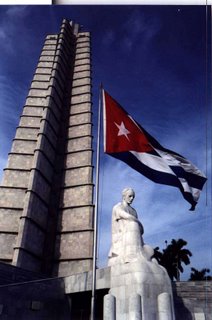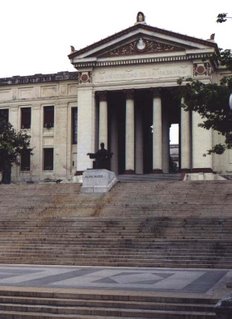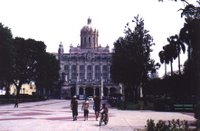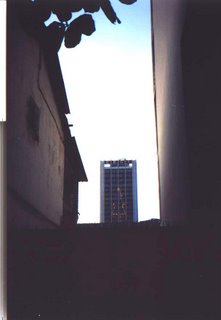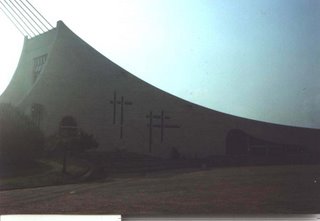2004 Cuba – Part 2, Pinar del Rio
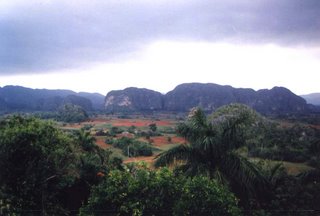 We headed out to the province of Pinar del Rio for a day trip with a tour bus. It was structured and rushed, but we did get to see a lot that day. Perhaps the most beautiful sights were the limestone hills in Vinales. These are reminiscent of the limestone hills in Guilin, China.
We headed out to the province of Pinar del Rio for a day trip with a tour bus. It was structured and rushed, but we did get to see a lot that day. Perhaps the most beautiful sights were the limestone hills in Vinales. These are reminiscent of the limestone hills in Guilin, China.
Another fun activity of the day was riding around in a boat through caves down an underground river in Vinales. It felt really touristy, but I have to admit that I enjoyed it.

We also visited a tobacco farmer and a cigar making factory. Tobacco is one of the country’s main exports. It was really interesting to see the process of cigar making from the field, to the leaves drying in the tobacco barns, to the factories. The factory is set up like a sweat shop where people sit at their stations and roll their cigars all day. Some tourists handed over things like soap and pens to the workers, who accepted these tokens eagerly.
It was interesting to see people lined up on the highway waiting for rides into Havana. Hitchhiking for Cubans is sanctioned by the government, and so drivers are expected to stop and pick up hitchhikers. At designated hitchhiking spots there were police directing the vehicles and organizing the hitchhikers.

Final thoughts: I enjoyed Cuba very much. We ate lots of icecream and listened to lots of music. However, we agreed that we would have gotten a lot more out of the trip if we had a better handle on Spanish. There are not a lot of people speaking English, and I think it is much easier to gain people’s trust and interest if you are attempting to communicate in their language. I was impressed with the way this country and its people have pulled together and succeeded to have such strong education and health care systems, agricultural forethought, creative energy, and political strength through some very difficult challenges. People in general seemed happy and vibrant.
There are a lot of questions about where this country will go in the next little while, whether the politics will change drastically when Castro is no longer around, or whether the people will hold onto his dream. I think that in many ways this country, under the leadership of Fidel Castro, has been able to accomplish many successes that have proved nearly impossible in most of the rest of the world. I am saddened to think that this country may melt back into the capitalist mould that the majority of the world holds in such high regard after he is gone. However, hopefully they will be able to strike a balance.
 We headed out to the province of Pinar del Rio for a day trip with a tour bus. It was structured and rushed, but we did get to see a lot that day. Perhaps the most beautiful sights were the limestone hills in Vinales. These are reminiscent of the limestone hills in Guilin, China.
We headed out to the province of Pinar del Rio for a day trip with a tour bus. It was structured and rushed, but we did get to see a lot that day. Perhaps the most beautiful sights were the limestone hills in Vinales. These are reminiscent of the limestone hills in Guilin, China.Another fun activity of the day was riding around in a boat through caves down an underground river in Vinales. It felt really touristy, but I have to admit that I enjoyed it.

We also visited a tobacco farmer and a cigar making factory. Tobacco is one of the country’s main exports. It was really interesting to see the process of cigar making from the field, to the leaves drying in the tobacco barns, to the factories. The factory is set up like a sweat shop where people sit at their stations and roll their cigars all day. Some tourists handed over things like soap and pens to the workers, who accepted these tokens eagerly.
It was interesting to see people lined up on the highway waiting for rides into Havana. Hitchhiking for Cubans is sanctioned by the government, and so drivers are expected to stop and pick up hitchhikers. At designated hitchhiking spots there were police directing the vehicles and organizing the hitchhikers.

Final thoughts: I enjoyed Cuba very much. We ate lots of icecream and listened to lots of music. However, we agreed that we would have gotten a lot more out of the trip if we had a better handle on Spanish. There are not a lot of people speaking English, and I think it is much easier to gain people’s trust and interest if you are attempting to communicate in their language. I was impressed with the way this country and its people have pulled together and succeeded to have such strong education and health care systems, agricultural forethought, creative energy, and political strength through some very difficult challenges. People in general seemed happy and vibrant.
There are a lot of questions about where this country will go in the next little while, whether the politics will change drastically when Castro is no longer around, or whether the people will hold onto his dream. I think that in many ways this country, under the leadership of Fidel Castro, has been able to accomplish many successes that have proved nearly impossible in most of the rest of the world. I am saddened to think that this country may melt back into the capitalist mould that the majority of the world holds in such high regard after he is gone. However, hopefully they will be able to strike a balance.
